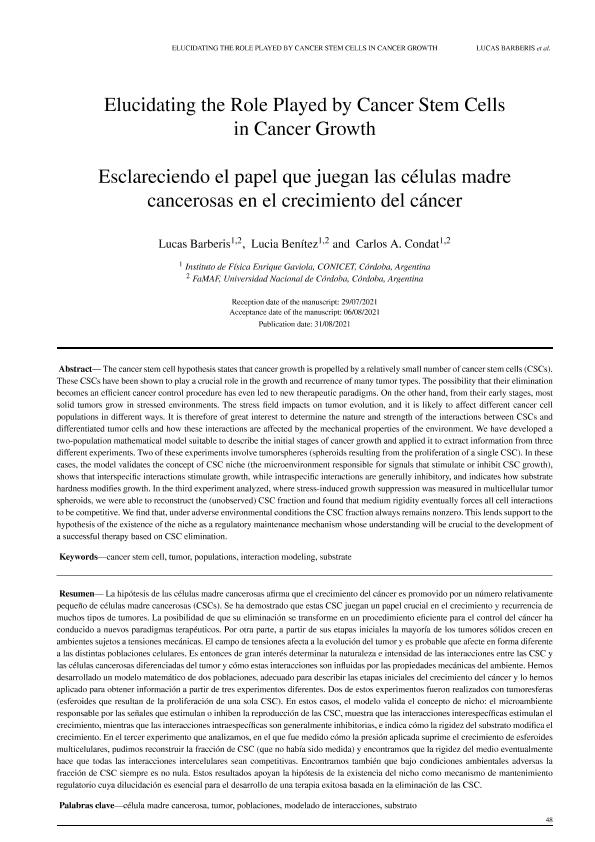Mostrar el registro sencillo del ítem
dc.contributor.author
Barberis, Lucas Miguel

dc.contributor.author
Benitez, Lucia

dc.contributor.author
Condat, Carlos

dc.date.available
2023-01-20T13:10:18Z
dc.date.issued
2021-08
dc.identifier.citation
Barberis, Lucas Miguel; Benitez, Lucia; Condat, Carlos; Elucidating the Role Played by Cancer Stem Cells in Cancer Growth; Universidad Tecnológica Metropolitana; Revista de Modelamiento Matemático de Sistemas Biológicos; 1; 1; 8-2021; 48-54
dc.identifier.issn
2735-6817
dc.identifier.uri
http://hdl.handle.net/11336/185108
dc.description.abstract
La hipótesis de las células madre cancerosas afirma que el crecimiento del cáncer es promovido por un número relativamente pequeño de células madre cancerosas (CSCs). Se ha demostrado que estas CSC juegan un papel crucial en el crecimiento y recurrencia de muchos tipos de tumores. La posibilidad de que su eliminación se transforme en un procedimiento eficiente para el control del cáncer ha conducido a nuevos paradigmas terapéuticos. Por otra parte, a partir de sus etapas iniciales la mayoría de los tumores sólidos crecen en ambientes sujetos a tensiones mecánicas. El campo de tensiones afecta a la evolución del tumor y es probable que afecte en forma diferente a las distintas poblaciones celulares. Es entonces de gran interés determinar la naturaleza e intensidad de las interacciones entre las CSC y las células cancerosas diferenciadas del tumor y cómo estas interacciones son influidas por las propiedades mecánicas del ambiente. Hemos desarrollado un modelo matemático de dos poblaciones, adecuado para describir las etapas iniciales del crecimiento del cáncer y lo hemos aplicado para obtener información a partir de tres experimentos diferentes. Dos de estos experimentos fueron realizados con tumoresferas (esferoides que resultan de la proliferación de una sola CSC). En estos casos, el modelo valida el concepto de nicho: el microambiente responsable por las señales que estimulan o inhiben la reproducción de las CSC, muestra que las interacciones interespecíficas estimulan el crecimiento, mientras que las interacciones intraespecíficas son generalmente inhibitorias, e indica cómo la rigidez del substrato modifica el crecimiento. En el tercer experimento que analizamos, en el que fue medido cómo la presión aplicada suprime el crecimiento de esferoides multicelulares, pudimos reconstruir la fracción de CSC (que no había sido medida) y encontramos que la rigidez del medio eventualmente hace que todas las interacciones intercelulares sean competitivas. Encontramos también que bajo condiciones ambientales adversas la fracción de CSC siempre es no nula. Estos resultados apoyan la hipótesis de la existencia del nicho como mecanismo de mantenimiento regulatorio cuya dilucidación es esencial para el desarrollo de una terapia exitosa basada en la eliminación de las CSC.
dc.description.abstract
The cancer stem cell hypothesis states that cancer growth is propelled by a relatively small number of cancer stem cells (CSCs). These CSCs have been shown to play a crucial role in the growth and recurrence of many tumor types. The possibility that their elimination becomes an efficient cancer control procedure has even led to new therapeutic paradigms. On the other hand, from their early stages, most solid tumors grow in stressed environments. The stress field impacts on tumor evolution, and it is likely to affect different cancer cell populations in different ways. It is therefore of great interest to determine the nature and strength of the interactions between CSCs and differentiated tumor cells and how these interactions are affected by the mechanical properties of the environment. We have developed a two-population mathematical model suitable to describe the initial stages of cancer growth and applied it to extract information from three different experiments. Two of these experiments involve tumorspheres (spheroids resulting from the proliferation of a single CSC). In these cases, the model validates the concept of CSC niche (the microenvironment responsible for signals that stimulate or inhibit CSC growth), shows that interspecific interactions stimulate growth, while intraspecific interactions are generally inhibitory, and indicates how substrate hardness modifies growth. In the third experiment analyzed, where stress-induced growth suppression was measured in multicellular tumor spheroids, we were able to reconstruct the (unobserved) CSC fraction and found that medium rigidity eventually forces all cell interactions to be competitive. We find that, under adverse environmental conditions the CSC fraction always remains nonzero. This lends support to the hypothesis of the existence of the niche as a regulatory maintenance mechanism whose understanding will be crucial to the development of a successful therapy based on CSC elimination.
dc.format
application/pdf
dc.language.iso
eng
dc.publisher
Universidad Tecnológica Metropolitana
dc.rights
info:eu-repo/semantics/openAccess
dc.rights.uri
https://creativecommons.org/licenses/by-nc-sa/2.5/ar/
dc.subject
CÉLULA MADRE CANCEROSA
dc.subject
TUMOR
dc.subject
POBLACIONES
dc.subject
MODELADO DE INTERACCIONES
dc.subject
SUBSTRATO
dc.subject.classification
Otras Ciencias Físicas

dc.subject.classification
Ciencias Físicas

dc.subject.classification
CIENCIAS NATURALES Y EXACTAS

dc.subject.classification
Matemática Aplicada

dc.subject.classification
Matemáticas

dc.subject.classification
CIENCIAS NATURALES Y EXACTAS

dc.subject.classification
Biología Celular, Microbiología

dc.subject.classification
Ciencias Biológicas

dc.subject.classification
CIENCIAS NATURALES Y EXACTAS

dc.title
Elucidating the Role Played by Cancer Stem Cells in Cancer Growth
dc.title
Esclareciendo el papel que juegan las células madre cancerosas en el crecimiento del cáncer
dc.type
info:eu-repo/semantics/article
dc.type
info:ar-repo/semantics/artículo
dc.type
info:eu-repo/semantics/publishedVersion
dc.date.updated
2022-09-22T10:30:22Z
dc.identifier.eissn
2735-7155
dc.journal.volume
1
dc.journal.number
1
dc.journal.pagination
48-54
dc.journal.pais
Chile

dc.journal.ciudad
Santiago de Chile
dc.description.fil
Fil: Barberis, Lucas Miguel. Universidad Nacional de Córdoba. Facultad de Matemática, Astronomía y Física; Argentina. Consejo Nacional de Investigaciones Científicas y Técnicas. Centro Científico Tecnológico Conicet - Córdoba. Instituto de Física Enrique Gaviola. Universidad Nacional de Córdoba. Instituto de Física Enrique Gaviola; Argentina
dc.description.fil
Fil: Benitez, Lucia. Universidad Nacional de Córdoba. Facultad de Matemática, Astronomía y Física; Argentina. Consejo Nacional de Investigaciones Científicas y Técnicas. Centro Científico Tecnológico Conicet - Córdoba. Instituto de Física Enrique Gaviola. Universidad Nacional de Córdoba. Instituto de Física Enrique Gaviola; Argentina
dc.description.fil
Fil: Condat, Carlos. Universidad Nacional de Córdoba. Facultad de Matemática, Astronomía y Física; Argentina. Consejo Nacional de Investigaciones Científicas y Técnicas. Centro Científico Tecnológico Conicet - Córdoba. Instituto de Física Enrique Gaviola. Universidad Nacional de Córdoba. Instituto de Física Enrique Gaviola; Argentina
dc.journal.title
Revista de Modelamiento Matemático de Sistemas Biológicos
dc.relation.alternativeid
info:eu-repo/semantics/altIdentifier/url/https://revistammsb.utem.cl/articulos/elucidating-the-role-played-by-cancer-stem-cells-in-cancer-growth/
Archivos asociados
